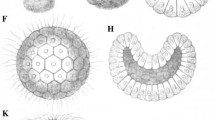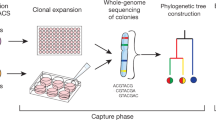Abstract
Human stem cell studies are difficult because many of the powerful experimental approaches that mark and follow stem cells and their progeny are impractical. Moreover, humans are long-lived, and it would literally take a lifetime to follow stem cell fates prospectively. Considering these hurdles, an ideal method would not require prior experimental manipulations but still allow “observations” of human stem cells from birth to death. The purpose of this review is to outline how histories or fates are likely to be surreptitiously recorded within somatic cell genomes by replication errors (molecular clock hypothesis). It may be possible to reconstruct stem cell lifetimes by measuring the random somatic changes that accumulate within their genomes, or the genomes of their more-easy-to-identify progeny.









Similar content being viewed by others
References
Bromham, L., & Penny, D. (2003). The modern molecular clock. Nature Reviews Genetics, 4, 216–224.
Shibata, D., & Tavaré, S. (2006). Counting divisions in a human somatic cell tree: how, what and why? Cell Cycle, 5, 610–614.
Potten, C. S., & Loeffler, M. (1990). Stem cells: attributes, cycles, spirals, pitfalls and uncertainties. Lessons for and from the crypt. Development, 110, 1001–1020.
Kay, H. E. (1965). How many cell-generations? Lancet, 15, 418–419.
Wang, T. L., Rago, C., Silliman, N., Ptak, J., Markowitz, S., Willson, J. K., et al. (2002). Prevalence of somatic alterations in the colorectal cancer cell genome. Proceedings of the National Academy of Sciences of the United States of America, 99, 3076–3080.
Bird, A. (2002). DNA methylation patterns and epigenetic memory. Genes & Development, 16, 6–21.
Ahuja, N., Li, Q., Mohan, A. L., Baylin, S. B., & Issa, J. P. (1998). Aging and DNA methylation in colorectal mucosa and cancer. Cancer Research, 58, 5489–5494.
Issa, J. P. (2000). CpG-island methylation in aging and cancer. Current Topics in Microbiology and Immunology, 249, 101–118.
Morgan, H. D., Santos, F., Green, K., Dean, W., & Reik W. (2005). Epigenetic reprogramming in mammals. Human Molecular Genetics, 14, R47–R58.
Jones, P. A., & Laird, P. W. (1999). Cancer epigenetics comes of age. Nature Genetics, 21, 163–167.
Yatabe, Y., Tavaré, S., & Shibata, D. (2001). Investigating stem cells in human colon by using methylation patterns. Proceedings of the National Academy of Sciences of the United States of America, 98, 10839–10844.
Velicescu, M., Weisenberger, D. J., Gonzales, F. A., Tsai, Y. C., Nguyen, C. T., & Jones, P. A. (2002). Cell division is required for de novo methylation of CpG islands in bladder cancer cells. Cancer Research, 62, 2378–2384.
Kim, J. Y., Siegmund, K. D., Tavaré, S., & Shibata, D. (2005). Age-related human small intestine methylation: evidence for stem cell niches. BMC Medical, 3, 10.
Kim, J. Y., Tavaré, S., & Shibata, D. (2005). Counting human somatic cell replications: methylation mirrors endometrial stem cell divisions. Proceedings of the National Academy of Sciences of the United States of America, 102, 17739–17744.
Kim, J. Y., Tavaré, S., & Shibata, D. (2006). Human hair genealogies and stem cell latency. BMC Biology, 4, 2.
Fuchs, E., Tumbar, T., & Guasch, G. (2004). Socializing with the neighbors: stem cells and their niche. Cell, 116, 769–778.
Wright, D. E., Wagers, A. J., Gulati, A. P., Johnson, F. L., & Weissman, I. L. (2001). Physiological migration of hematopoietic stem and progenitor cells. Science, 294, 1933–1936.
Spradling, A., Drummond-Barbosa, D., & Kai, T. (2001). Stem cells find their niche. Nature, 414, 98–104.
Nowell, P. C. (1976). The clonal evolution of tumor cell populations. Science, 194, 23–28.
Marshman, E., Booth, C., & Potten, C. S. (2002). The intestinal epithelial stem cell. Bioessays, 24, 91–98.
Campbell, F., Williams, G. T., Appleton, M. A., Dixon, M. F., Harris, M., & Williams, E. D. (1996). Post-irradiation somatic mutation and clonal stabilisation time in the human colon. Gut, 39, 569–573.
Calabrese, P., Tavaré, S., & Shibata, D. (2004). Pre-tumor progression: clonal evolution of human stem cell populations. American Journal of Pathology, 164, 1337–1346.
Kim, K. M., Calabrese, P., Tavaré, S., & Shibata, D. (2004). Enhanced stem cell survival in familial adenomatous polyposis. American Journal of Pathology, 164, 1369–1377.
Preston-Martin, S., Pike, M. C., Ross, R. K., Jones, P. A., & Henderson, B. E. (1990). Increased cell division as a cause of human cancer. Cancer Research, 50, 7415–7421.
Nicolas, P., Kim, K. M., Shibata, D., & Tavaré, S. (2007). The stem cell population of the human colon crypt: analysis via methylation patterns. PLoS Computational Biology, 3, e28.
Author information
Authors and Affiliations
Corresponding author
Rights and permissions
About this article
Cite this article
Shibata, D., Tavaré, S. Stem Cell Chronicles: Autobiographies Within Genomes. Stem Cell Rev 3, 94–103 (2007). https://doi.org/10.1007/s12015-007-0022-6
Published:
Issue Date:
DOI: https://doi.org/10.1007/s12015-007-0022-6




